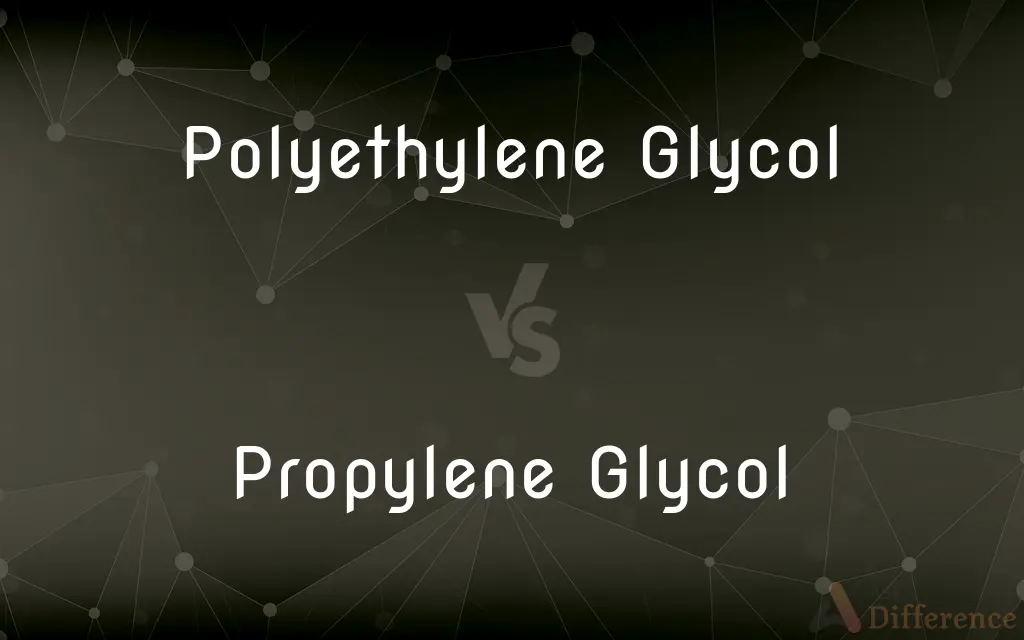Polyethylene Glycol vs. Propylene Glycol — What's the Difference?
By Tayyaba Rehman — Published on November 22, 2023
Polyethylene Glycol (PEG) and Propylene Glycol (PG) are both synthetic polymers: PEG is used in medicine and cosmetics, while PG is found in food, cosmetics, and antifreeze.

Difference Between Polyethylene Glycol and Propylene Glycol
Table of Contents
ADVERTISEMENT
Key Differences
Polyethylene Glycol is widely recognized for its ability to facilitate bowel movement, making it a common ingredient in medical laxatives. Propylene Glycol, on the other hand, doesn’t share this medicinal utility, but is known for its capability to lower the freezing point of water, hence, it’s used as a de-icing fluid in aviation and an antifreeze in food-grade applications.
In skincare and cosmetic applications, Polyethylene Glycol is often utilized for its moisturizing properties, ensuring the skin retains moisture. Comparatively, Propylene Glycol is valued in the cosmetic industry as well, but it functions as a skin conditioning agent, solvent, and also helps in maintaining the consistency of formulations.
Polyethylene Glycol, due to its biocompatible nature, is often used in the pharmaceutical industry as a solvent, plasticizer, surfactant, ointments, and suppository base. On a parallel note, Propylene Glycol is prominent in pharmaceuticals too but majorly as a solvent for oral, injectable, and topical formulations, because of its ability to mix with a wide range of substances.
In industrial applications, Polyethylene Glycol is commonly utilized as a surfactant in detergents and as a lubricant in various industries. Contrastingly, Propylene Glycol serves as a moisture-retaining agent and carrier for flavor compounds in food and beverage industries.
It’s notable that Polyethylene Glycol variants are commonly used in biochemistry and pharmacology due to their low toxicity. Propylene Glycol, while used in food processing, has sparked some health concerns and is not as favored in applications that require prolonged direct contact with the body, such as in certain medical devices, due to potential irritation.
ADVERTISEMENT
Comparison Chart
Chemical Structure
A polymer of ethylene oxide
A synthetic organic compound
Common Uses
Laxatives, skin creams
Antifreeze, food and drink, solvents
In Pharmaceuticals
Surfactant, ointment base
Solvent for formulations
Toxicity Level
Generally low toxicity
Can be irritant in some contexts
Industrial Application
Surfactant, lubricant
Moisture agent, carrier for flavors
Compare with Definitions
Polyethylene Glycol
In the industrial realm, Polyethylene Glycol is recognized as a surfactant in detergents.
Polyethylene Glycol enhances the cleaning capabilities of industrial detergents.
Propylene Glycol
It is utilized in the production of antifreeze and de-icing solutions.
Propylene Glycol lowers the freezing point of water, making it ideal for de-icing airplanes.
Polyethylene Glycol
Polyethylene Glycol is used in the medical field as a solubilizing agent.
Polyethylene Glycol enables certain drug formulations to dissolve more efficiently.
Propylene Glycol
In the pharmaceutical industry, Propylene Glycol is known as a solvent.
Medications often utilize Propylene Glycol to dissolve certain active ingredients.
Polyethylene Glycol
PEG, as often referred, is acknowledged for its laxative properties.
Patients are sometimes given Polyethylene Glycol before a colonoscopy.
Propylene Glycol
Propylene Glycol is a synthetic liquid substance that absorbs water.
Propylene Glycol is commonly used to make polyester compounds.
Polyethylene Glycol
Polyethylene Glycol is known for its role in enhancing skin hydration in cosmetics.
Lotions containing Polyethylene Glycol can provide moisturizing benefits to the skin.
Propylene Glycol
Propylene Glycol is a versatile substance used as a food additive.
Propylene Glycol helps maintain moisture in certain food items.
Polyethylene Glycol
Polyethylene Glycol is a polyether compound utilized for varied applications.
The doctor prescribed a solution containing Polyethylene Glycol to help with constipation.
Propylene Glycol
Propylene Glycol can act as a skin-conditioning agent in cosmetics.
The cream contains Propylene Glycol to soften and smooth the skin.
Common Curiosities
Is Polyethylene Glycol the same as Ethylene Glycol?
No, they are different compounds with distinct properties and uses.
Is Propylene Glycol safe in food?
Generally yes, it's recognized as generally safe by the FDA, but quantity limitations exist.
Can Polyethylene Glycol be used in skincare?
Yes, it's used in various skincare products for its moisturizing properties.
What is the appearance of Polyethylene Glycol?
Polyethylene Glycol typically appears as a white, waxy, solid material.
Can Propylene Glycol cause allergic reactions?
Yes, some individuals may experience allergic reactions to Propylene Glycol, such as skin irritation or hives.
What is Polyethylene Glycol used for in medicine?
It's often used as a laxative and in some preparations for medical procedures, like colonoscopies.
What is a common use of Propylene Glycol in industry?
It is commonly used in antifreeze and de-icing solutions.
Can Polyethylene Glycol be utilized in producing plastics?
Yes, Polyethylene Glycol can be used in manufacturing certain types of plastics.
Is Polyethylene Glycol found in everyday products?
Yes, Polyethylene Glycol can be found in items like skin creams, toothpaste, and even certain foods.
Is Propylene Glycol used in inhalers and vaping devices?
Yes, Propylene Glycol is used in many inhalable formulations due to its ability to create artificial smoke or vapor.
Is Polyethylene Glycol safe for all ages?
Not always. PEG's safety can depend on factors like age and health, and its usage in children and the elderly should be monitored.
Does Propylene Glycol have a role in manufacturing plastics?
Yes, Propylene Glycol is used to make certain types of polyester resins.
Share Your Discovery

Previous Comparison
Class 2 Hitch vs. Class 3 Hitch
Next Comparison
Payback Period vs. Discounted Payback PeriodAuthor Spotlight
Written by
Tayyaba RehmanTayyaba Rehman is a distinguished writer, currently serving as a primary contributor to askdifference.com. As a researcher in semantics and etymology, Tayyaba's passion for the complexity of languages and their distinctions has found a perfect home on the platform. Tayyaba delves into the intricacies of language, distinguishing between commonly confused words and phrases, thereby providing clarity for readers worldwide.
















































